Blood was big business in postwar Japan. Like many industries in the country, its growth was entangled with warfare past and present in a wonderfully disturbing way.
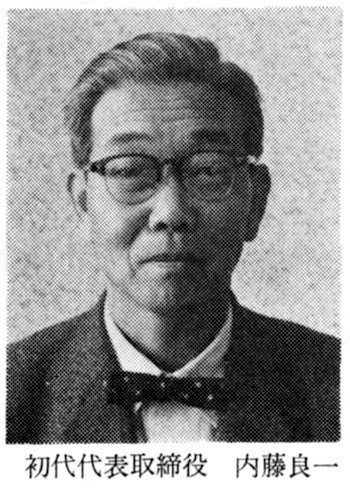
In the early post-surrender years of low employment opportunities and black market inflation, blood banks – known in Japan by their English name and its literal translation ketsueki ginkō – offered a lifeline for the poor. Public donation of blood had not been popular in Japan during the war, but nonetheless the country was well primed to collect, store, and process blood for transfusions and plasma products for a rather icky reason: Dr. Naitō Ryōichi, founder and president of Nihon Blood Bank (Nihon buraddo banku, later renamed Green Cross), the largest blood bank in Japan, and for a time the largest in the world, had intimate experience with putting things in and taking things out of people’s circulatory systems as former head of Unit 731, the Japanese military’s secret bacteriological warfare division. Less problematic, in 1943, with the bombing of Japanese cities imminent, Naitō also helped create the Patriotic Donors Association, though it failed for lack of support. In 1951, when he established Nihon Blood Bank, Naitō’s high-level insider connections allowed him to requisition plasma-processing machinery from the government, which had formerly been used by the military. Nihon Pharmaceuticals (Nihon seiyaku), the second largest blood company, also had former Unit 731 doctors amongst its staff.
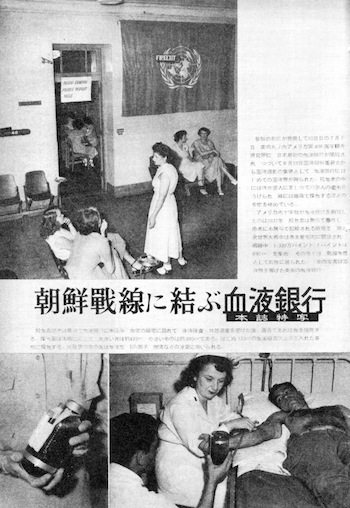
Where once the Japanese military provided, the Americans subsequently stepped in. Historians agree that the Korean War was a major factor in relaunching Japan’s economy. The industries benefitting most were naturally those connected to war procurements: steel, clothes, jeeps, petrochemicals, and napalm, for example. With a number of United Nations rear hospitals located in Japan, whole blood and especially blood plasma was likewise in urgent demand. Dry plasma sourced in Japan was also sent to the front. Meanwhile in the United States, “It doesn’t matter whether the blood comes from a Japanese, a Scotsman, a Negro, or an East Indian,” said the Office of Defense Mobilization to American citizens, urging them to donate for the Korean War – and foreshadowing the international consanguinity that was to cause so much trouble in the global blood trade after the 70s.
Advertised in the press as “the first blood bank in Japan,” the American GHQ set up a blood collection center in Tokyo in July 1950, ten days after the outbreak of the Korean War. The Red Cross, which had been active in Japan since the late nineteenth century, followed suit by setting up numerous donation centers in and near major Japanese cities. Their pride and joy, however, was the new Tokyo Blood Center at the Red Cross Hospital in Hiroo. Its goal was to establish a true donation system and culture in Japan, and was celebrated as such in the press alongside similar endeavors at a handful of university research laboratories.
Though most such articles seem to have appeared in public health and medical journals, children’s magazines also tried to help in cultivating a culture of donation. For example, in a “manga report” for Schoolgirls Friend (Jogakusei no tomo, November 1953), cartoonist Negishi Komichi takes the reader to the very same Tokyo Blood Center.
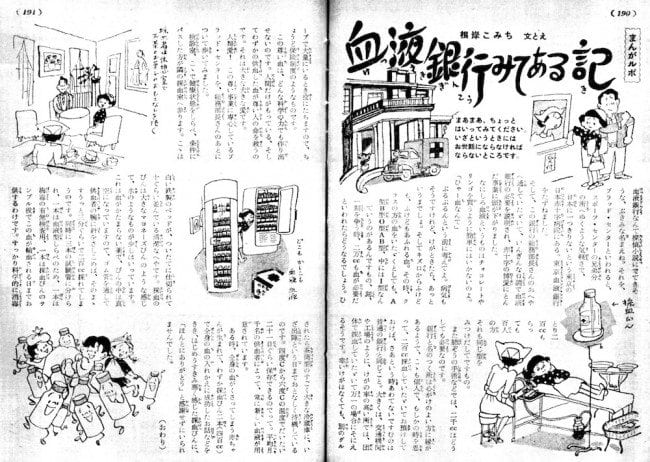
“Blood banks sure do sound like something scary from a detective novel,” she begins, “but if you think of them as blood centers, like the elder brother of sports centers, you can walk right in without a worry.” Everything is clean and orderly. The nurses are nice and the doctors caring and professional. After giving blood, donors are, according to one Matsumoto Katsuji-esque illustration, invited to rest in a fancy Western-style room, where they are served tea and cake while relaxing in plush chairs and surrounded by tasteful oil paintings. The Blood Center itself is made to look like a mansion out of a shojo manga. Negishi’s entire reportage, in fact, gushes with the sentiments of the genre. “This noble blood, no power of science can create it. Only humans have it. And with just a little bit of donated blood, the noble life of a person can be saved. What big big love. What love of humanity!” At the heart of this “noble business” is, of course, the Red Cross.
The reality, however, was that the Red Cross was failing in Japan. In its first year after opening (1952), the Tokyo Blood Center was able to attract only 507 donors. In 1954, that number had dropped to a meager 103, this in one of the most populous cities in the world. One hindrance was superstitions holding that giving blood invited the wrath of one’s ancestors and the destruction of the body. A much greater problem was, as mentioned earlier, the near absence of a tradition of voluntary donation.
Unlike in Britain and the United States, there had been no concerted efforts at organizing blood drives on a national scale in Japan during the war. The military frontline was poorly supplied as a result, and the giving of blood was never established as a common good. After the war, the United States and Britain institutionalized a system of blood credits, with public campaigns informing people that giving was an essential counterpart to receiving. Meanwhile, national health insurance in Japan guaranteed a free supply to patients, throwing up yet another obstacle in convincing people of the need to give. “Even the Japanese Red Cross, which began as a non-remunerated service,” writes Douglas Starr in his page-turning history of blood, “found it impossible to attract volunteers and began paying its donors in 1955.” What transpired in the United States in the 50s – the establishment of for-profit blood banks whose providers were mainly the urban poor – thus developed in Japan on a scale manifold larger. By the time the blood industry became a major public issue in the early 60s, 97.5 percent of the nation’s blood supply was said to come from buying. In the United States, the number was about 60 percent, though it varied from state to state.
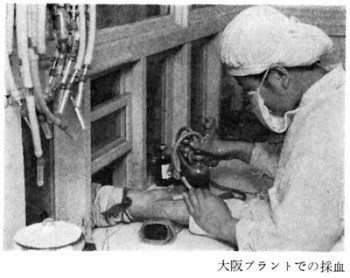
The keyword was baiketsu, meaning “sold blood,” or on occasion (a homonym written with different kanji) “bought blood.” While in many other countries there was a formidable opposition to commercialized blood banking on ethical and medical grounds, in Japan initially few people were inclined to dissent. On the supply side, at 400 yen for 200 cc (0.42 pints) in the early 50s, selling blood was economically a better option (at least in the short term) than, say, construction work, which paid a standard rate of 240 yen for a day’s labor. The mark-up before selling to hospitals was around 300 percent, much higher (like twofold higher) than what was standard in the United States. But as Japanese national health insurance covered transfusions for free, few cared.
Anyway, hospitals and patients desperately needed the blood. “Even mildly complicated surgeries required huge transfusions in that era,” wrote one medical activist from the period. “Then with the arrival of automobile society, there was a drastic increase in traffic accidents, further exacerbating the lack of blood reserves. It was a total seller’s market for the commercial blood banks involved in baiketsu. And of course, it’s not like commercial blood banks ran as goodwill operations. As business enterprises, they naturally pursue profit. However, what they are supplying is transfusion blood. One would therefore expect them to exercise moderation and business ethics on their own accord.” The point, of course, was that they didn’t. And if a seller’s market vis-à-vis the hospitals guaranteed a free hand on the product end of the business, so an endless stream of poor people ensured a buyer’s market for the banks at the resource end. In 1964, it was no longer 200 cc but 400 cc (0.84 pints) that paid the equivalent (1650 yen) of a day’s heavy labor. Remember, it was 500 cc that Mizuki’s red tree extracts daily in 1960 before turning its victim into wood.

The commercial blood industry grew like mad. In 1951, Nihon Blood Bank and Nihon Pharmaceuticals had one plant each. By 1955, together they boasted twenty across the country. While doctors in the United States fought desperately to keep up the guise of blood as a medical “service,” in Japan there was frank recognition of the blood trade as an industry. Both pharmaceutical companies and the press referred to collection centers primarily as kōjō (factories) or the English word “plant,” thus emphasizing processing and manufacture, not storage and distribution as implied by the banking metaphor that, as Kara Swanson has shown, dominated discourse in the United States. These were body factories, not body banks.
Since blood products were a factory operation, the importation of raw material was inevitably a disconcerting sight. The human scene around blood banks caught the eyes of many journalists. “On busy days maybe a thousand, on usual days a few hundred, form a long line in front of the factory,” reported the Mainichi Shinbun in 1950, in an article about the Nihon Pharmaceutical plant in Katsushika Ward in Tokyo. “The donors begin fighting for position in the line from five in the morning. Since the gates only open at eight, people try to keep warm by setting fires, sometimes ripping apart the fencing of the factory or that of nearby private home to use as firewood. Businessmen buy and sell chits for a better number in line, while other donors are shaken down and have their chits stolen.”

Cartoonist Tsuge Tadao describes as his genfūkei (his “primal landscape,” the place where one’s consciousness first forms and will always return) having witnessed, as a child in the early 50s, hundreds of “lumpen types” sullenly waiting to get their blood taken at the very same Katsushika plant. “They simply stood in a long line, compliantly, their eyes down, and smelling of dust and sweat. The calmness hung like some strange evil.” He would join the plant as staff in the mid 50s, more on which next time.
Others recall worse scenes in other cities, in Osaka for example. Before official blood banks were established, the indigent could only sell their blood to middlemen. Death from overselling was not rare. Hard-up laborers might find work as “throwers” (nagekomiya), hired to toss dead bodies into rivers or the sea. At Nihon Blood Bank’s Kyōbashi Plant in Osaka, established in 1951, the symbolic contradictions were clearest once the sun set. Recalled one man, one often saw scores of people passed out below the elevated train tracks that cut through Kyōbashi, immobilized from having sold too much blood, and deaf to the clattering freight trains carrying American tanks and artillery above.
Even without the striking contrast of American might, the links between blood and economic disparities in Japan were obvious. The press might have reported sellers from across the social spectrum – “students, 240-yen-a-day laborers [nikoyon], salary men, and housewives of all classes” (1954) – but this was simply an indicator of the extensiveness of economic hardship after the war, not of the breadth of Japanese charity. Even during the early 50s, even before the economy improved, the primary and paradigmatic blood-sellers were, like in the United States, the homeless and the unemployed. Many plants, in fact, were intentionally sited in poor neighborhoods and near day labor markets so that they could more easily access those populations.

When the Korean War ended in 1953, the demand for dry plasma disappeared practically overnight. It was a blow to the fledgling industry. But a law passed the following year arrived to ensure continued growth. By classifying blood as a pharmaceutical commodity, the law essentially gave “blood banks” a free hand in collecting, processing, and distributing what was a sensitive and pathologically susceptible human tissue. A company with the technology and technical know-how of Nihon Blood Bank could turn the blood it extracted into fractionated plasma products, like gamma globulin and albumin. Yet the biggest and most lucrative market was for whole blood for transfusion. Pharmaceutical companies grew rapidly on whole blood sales, but so did hundreds of small-time “donor intermediary agencies” (kyōketsu assen gyōsha), which arranged whole blood donors to hospitals for a fee.
Though some of these middlemen descended from the Blood Transfusion Association (Yuketsu kyōkai), which had been established to benefit injured veterans and civilians during World War II, most were fly-by-night operations with roots in Occupation-era black markets. Their street name of “blood merchants” (chi no akindo) was fully deserved. Some were more horrible than the Bowery butchers of Graham Ingels’s “Pickled Pints.” “In a room filled with a fermenting odor, sickly men with yellow complexions weakly watch the doctor’s activities,” reported Weekly Manga Sunday about one such outfit where a donor died from over-selling. “The entryway is a mess. Even during the day, the interiors are dark. The tatami are warped and have practically returned to straw. One step inside, and your nose is violently assailed with that fermenting smell unique to the homeless. There, professional donors (who are known as spenders) wait for a call from the office while sitting around a heated kotatsu table, which glitters with sweat and dirt.”

Changes in the law mercifully shut down most such operations in the late 50s, but only to increase the number of “spenders” (they used the English word) at the “legitimate” blood banks. That the problems were endemic was obvious to any visitor to Japanese slums. For example, in a study of “flophouse districts” (doya gai) of various cities conducted in 1964, sociologist Carlo Caldarola reported as follows: “In all the doya districts visited, one of the most acute social problems appeared to be the so-called baiketsu or blood-selling practice. There are two distinct categories of blood-sellers. One is made up of those who sell their blood only occasionally, such as in a period of prolonged unemployment or in case of some other emergency. The other category consists of those who are regular clients of a blood bank. They usually stimulate an over-production of blood by taking hematogenic tablets (zōketsuzai) every other day, thus becoming able to earn a livelihood almost exclusively through the practice of baiketsu. An habitual blood-seller is able to sell 200 C.C. of his blood up to forty times or more per month and is paid 400 yen each time. . . The habitual baiketsu practitioner is one who gets his livelihood without working at the expense of the blood resources of his own body. He may still be able to spend a substantial amount of money for gambling and drinks. To some doya people this seems to be the smartest way of living.”
Though one of the earliest sketches of the baiketsu problem in English, Caldarola’s article only repeats what had been widely reported in the Japanese press for years, since the early 50s. What was new about coverage in the 60s was the increased degree of insider access. Journalists and medical activists had started going undercover, disguised as bums, showing up in day labor markets like San’ya (Tokyo) and Kamagasaki (Osaka), asking around casually about the what-where-how of selling blood, and then infiltrating the plants to sell blood themselves and see what it really entailed.

Particularly influential was an article by Ishikawa Gan, a journalist for Asahi Shinbun who worked the police beat in Asakusa. “By eight in the morning,” wrote Ishikawa, “the workers of San’ya know their jobs for the day, and the street looks like the tide has pulled out. It’s right around that time that a group of fifty or sixty begins collecting in the neighborhood’s Tamahime Park. People wearing jikatabi and tsutsukake, mothers in aprons with their kids . . . if you look closely, their faces, one and all, are eerily pale. Then a bus pulls up before this group. The driver wears white. The people fight frantically, as if in battle, to get through the door. Those left behind wait for the next bus. . . . This is the Blood-Seller’s Courtesy Bus, sent by the blood banks to San’ya. Their destination is either the Katsushika Plant or the Ōji Plant [of Nihon Pharmaceuticals]. Four or five buses come at fixed times three or four times a day.” Upon returning from one plant in the morning, some people rushed to catch a bus to the other plant for a second blood sale in the afternoon. These buses – “saviors from hell,” in the words of one San’ya activist – were eventually stopped under pressure from police investigation.
When baiketsu was first scrutinized in the press in the early 60s, it was mainly with regards to how the industry exploited the poor. The desperate lives of blood sellers represented the continuation of forms of desperation and poverty that business and the government were claiming had been wiped out by economic growth and “the end of the postwar period.” They were the truth to lies of equitable growth for all. While the poor got weaker by selling their blood, incapacitating themselves for sustained work and in many cases shortening their lives, the middle class and affluent benefited by receiving increased access to health services. In a report conducted in San’ya in 1962 by medical students from Waseda University associated with the Red Cross, it was found that the majority of blood sellers sold anywhere between 4000 cc (8.5 pints) to more than 8000 cc (17 pints) a week (versus Ingels’s measly three pints a month), which meant two and sometimes three extractions a day (except for Sunday, when most banks were closed). This was the equivalent, activists graphically explained, of having your body’s entire blood supply drained once or twice in a single month.
Inevitably, “spenders” suffered from hospitalization and even death. Most ambulance calls to San’ya (on average, one every three days) were to pick up people who had passed out from giving too much blood. Laws existed to prevent this situation, but the blood banks were more than happy to help sellers break them. “Whenever they get desperate for money,” recalled one former blood bank employee about day laborers, “they come in and sell their blood. Most of them do it far too often. You know there are weight requirements for blood donors. Well, we’d be putting these guys on a scale and the next thing we know we’d find they’d put rocks in their pockets to get them up to standard weight.” These tricks could backfire, of course. If hospitalized, prodigal sellers, since poor and without health insurance, would be forced to buy back a transfusion costing many times the price they had got for the blood that they had just sold to put themselves in the hospital.
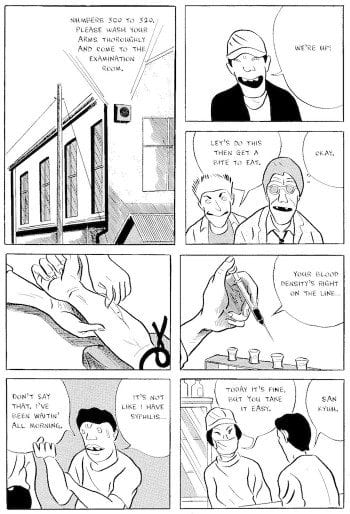
Let me close this segment with one of the most graphic descriptions of baiketsu. It comes, surprisingly enough, from a cartoonist, Tsuge Yoshiharu. It was written as an afterword for a collection of his brother Tsuge Tadao’s work from 1985, which included a number of the stories that appear in the new D&Q collection, Trash Market. As an occasional client, Yoshiharu knew the institution well. So did his mother, who sold her blood to support the family (the same family depicted in Tadao’s “Song of Shōwa” in Trash Market). Here is an abridged translation of Yoshiharu’s account.
I am embarrassed to say that I too frequently went to this same bank [Nihon Pharmaceutical’s Katsushika plant, where Tadao later worked] to sell my blood. This was in 1953 when I was sixteen. I was a minor, but I lied. . . . In a single visit, they take a full milk bottle’s worth of blood. That was all that was allowed. But since they only gave you 400 yen, there were many people who managed to have it “extracted” (to have it sold) twice in a single day. There were people who collapsed from anemia. The blood banks had no problem breaking the law to fill their quotas.
There were two ways that blood was taken. One was called the “immediate blood method,” in which they would take your blood on the spot without conducting any health tests. If you got tested, you received the large sum of 1000 yen, but then you had to go through four days of tests. Those who went to blood banks lacked the money to even get through the day, so waiting four days was out of the question. So most tended for the immediate method, despite knowing that the money was low. If you had your blood taken, you weren’t allowed to do it again for a month. But not only did people go twice in a single day, they would return again the next. Naturally their blood thinned. Even for the immediate method, they were strict about measuring your blood levels and refused to buy it if it was thin. People devised all kinds of ways to get around that. If you put a baseball under your armpit and squeeze, or tie a cord around your arm, or raise your arm high above your head to make the blood collect downwards, your density will test significantly higher.

Then there were people who didn’t try to hide that they had thin blood. That’s where the agents came in. These agents never had their blood taken, so their blood was always thick. When their client’s name was called, they would go nonchalantly into the examination room. The examination involved nothing more than the taking of a little bit of blood by needle. This was done right in front of the nurse’s eyes, but when it came to having your arm mark as “passed,” quickly the client stuck his arm out in place of the agent’s. The room was jammed with people, so tricking them was easy. And it’s not like the examiners knew all the agents’ faces. The agent’s fee was fifty yen. There was also the illegal selling of phony passing marks. That also cost fifty yen.
However, if you got too much blood taken, the inside of your eyelids lost their color. Or if you stuck out your tongue, it was white. This was a sign that your blood density had crossed the danger line. If you continued further, the final stage was “white eye." The whiteness of your inner eyelids becomes even more evident, and you develop a distinct white ring around your eyes like the mejiro bird [the Japanese White-eye]. At this point you were in absolutely no condition to be selling your blood. Yet there was this forty year-old woman who I saw get the fake passing mark nonetheless. She couldn’t even stand up, so she lay in the road while waiting her turn in line. I had to catch my breath when I saw her, thinned to the bone, looking as skinny as a ghost.
Yoshiharu is describing the early 50s. Judging from newspaper reports and activist medical pamphlets, little had changed ten years later. If Mizuki hadn’t told us that Kitarō’s mother was born a yūrei, a contemporary reader might have assumed that poverty had made her one.
(cont'd)






